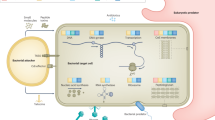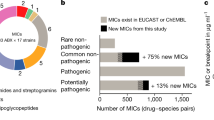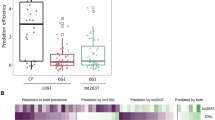Abstract
Bdellovibrio are predatory bacteria that invade the periplasm of other Gram-negative bacteria where they undergo a complex developmental cycle that culminates in killing of the prey cell. Their intracellular niche allows Bdellovibrio to feed without competition and their lytic action can rapidly reduce bacterial populations, including pathogens, making these predatory bacteria interesting potential candidates for therapeutic applications. With the complete genome sequence for one Bdellovibrio strain now available, researchers now have an opportunity to evaluate the therapeutic potential of these predatory bacteria.
This is a preview of subscription content, access via your institution
Access options
Subscribe to this journal
Receive 12 print issues and online access
$209.00 per year
only $17.42 per issue
Buy this article
- Purchase on Springer Link
- Instant access to full article PDF
Prices may be subject to local taxes which are calculated during checkout

Similar content being viewed by others
References
Varon, M. & Shilo, M. in Advances in Aquatic Microbiology, Vol. 2 (eds Droop, M. R. & Jannesch, H. W.) 1–41 (Academic Press, London, 1980).
Jurkevitch, E., Minz, D., Ramati, B. & Barel, G. Prey range characterization, ribotyping, and diversity of soil and rhizosphere Bdellovibriospp. isolated on phytopathogenic bacteria. Appl. Environ. Microbiol. 66, 2365–2371 (2000).
Schwudke, D., Strauch, E., Krueger, M. & Appel, B. Taxonomic studies of predatory bdellovibrios based on 16S rRNA analysis, ribotyping and the hit locus and characterization of isolates from the gut of animals. Syst. Appl. Microbiol. 24, 385–394 (2001).
Straley, S. C. & Conti, S. F. Chemotaxis by Bdellovibrio bacteriovorus toward prey. J. Bacteriol. 132, 628–640 (1977).
Lambert, C., Smith, M. C. M. & Sockett, R. E. A novel assay to monitor predator–prey interactions for Bdellovibrio bacteriovorus 109J reveals a role for methyl-accepting chemotaxis proteins in predation. Environ. Microbiol. 5, 127–132 (2003).
Kessel, M. & Shilo, M. Relationship of Bdellovibrio elongation and fission to host cell size. J. Bacteriol. 128, 477–480 (1976).
Thomashow, M. F. & Rittenberg, S. C. in Developmental Biology of Prokaryotes (ed. Parish, J. H.) (University of California Press, 1979).
Cotter, T. W. & Thomashow, M. F. A conjugation procedure for Bdellovibrio bacteriovorus and its use to identify DNA sequences that enhance the plaque-forming ability of a spontaneous host–independent mutant. J. Bacteriol. 174, 6011–6017 (1992).
Cotter, T. W. & Thomashow, M. F. Identification of a Bdellovibrio bacteriovorus genetic locus, hit, associated with the host-independent phenotype. J. Bacteriol. 174, 6018–6024 (1992).
Snyder, A. R., Williams, H. N., Baer, M. L., Walker, K. E. & Stine, O. C. 16S rDNA sequence analysis of environmental Bdellovibrio-and-like organisms (BALO) reveals extensive diversity. Int. J. Syst. Evol. Microbiol. 52, 2089–2094 (2002).
Flannagan, R. S., Valvano, M. A. & Koval, S. F. Downregulation of the motA gene delays the escape of the obligate predator Bdellovibrio bacteriovorus 109J from bdelloplasts of bacterial prey cells. Microbiology 150, 649–656 (2004).
Rendulic, S. et al. A predator unmasked: life cycle of Bdellovibrio bacteriovorus from a genomic perspective. Science 303, 689–692 (2004).
Ravenschlag, K., Sahm, K., Pernthaler, J. & Amann, R. High bacterial diversity in permanently cold marine sediments. Appl. Environ. Microbiol. 65, 3982–3289 (1999).
Baer, M. L., Ravel, J., Chun, J., Hill, R. T. & Williams, H. N. A proposal for the reclassification of Bdellovibrio stolpii and Bdellovibrio starrii into a new genus, Bacteriovorax gen. nov. as Bacteriovorax stolpii comb. nov. and Bacteriovorax starrii comb. nov., respectively. Int. J. Syst. Evol. Microbiol. 50, 219–224 (2000).
Sacchi, L. et al. A symbiont of the tick Ixodes ricinus invades and consumes mitochondria in a mode similar to that of the parasitic bacterium Bdellovibrio bacteriovorus. Tissue Cell 36, 43–53 (2004).
Tudor, J. J. & Conti, S. F. Characterization of bdellocysts of Bdellovibrio sp. J. Bacteriol. 131, 314–322 (1977).
Rittenberg, S. C. & Hespell, R. B. Energy efficiency of intraperiplasmic growth of Bdellovibrio bacteriovorus. J. Bacteriol. 121, 1158–1165 (1975).
Ruby, E. G. & McCabe, J. B. An ATP transport system in the intracellular bacterium, Bdellovibrio bacteriovorus 109J. J. Bacteriol. 167, 1066–1070 (1986).
Lambert, C. A genetic approach to predator–prey interactions in Bdellovibrio bacteriovorus. Ph.D. thesis Nottingham University (2002).
Roberts, R. C. & Ranu, R. S. Transfection of Bdellovibrio bacteriovorus with bacteriophage MAC-1 DNA. FEMS Microbiol. Lett. 43, 207–211 (1987).
Abram, D., Castro e Melo, J. & Chou, D. Penetration of Bdellovibrio bacteriovorus into host cells. J. Bacteriol. 118, 663–680 (1974).
Fackrell, H. B. & Robinson, J. Purification and characterization of a lytic peptidase produced by Bdellovibrio bacteriovorus 6-5-S. Can. J. Microbiol. 19, 659–666 (1973).
Thomashow, M. F. & Rittenberg, S. C. Intraperiplasmic growth of Bdellovibrio bacteriovorus 109J: solubilization of Escherichia coli peptidoglycan. J. Bacteriol. 135, 998–1007 (1978).
Thomashow, M. F. & Rittenberg, S. C. Intraperiplasmic growth of Bdellovibrio bacteriovorus 109J: N-deacetylation of Escherichia coli peptidoglycan amino sugars. J. Bacteriol. 135, 1008–1014 (1978).
Matin, A. & Rittenberg, S. C. Kinetics of deoxyribonucleic acid destruction and synthesis during growth of Bdellovibrio bacteriovorus strain 109D on Pseudomonas putida and Escherichia coli. J. Bacteriol. 111, 664–673 (1972).
Lederberg, J. Smaller fleas...ad infinitum: therapeutic bacteriophage redux. Proc. Natl Acad. Sci. USA 93, 3167–3168 (1996).
Fratamico, P. M. & Cooke, P. H. Isolation of bdellovibrios that prey on Escherichia coli 0157:H7 and Salmonella species and application for removal of prey from stainless steel surfaces. J. Food Safety 16, 161–173 (1996).
Richardson, I. R. The incidence of Bdellovibrio spp. in man-made water systems: co-existence with legionellas. J. Appl. Bacteriol. 69, 134–140 (1990).
Fratamico, P. M. & Whiting, R. C. Ability of Bdellovibrio bacteriovorus 109J to lyse Gram-negative food-borne pathogenic and spoilage bacteria. J. Food Protect. 58, 160–164 (1995).
Markelova, N. Y. Effect of toxic pollutants on Bdellovibrio. Process Biochem. 37, 1177–1181 (2002).
Varon, M. & Shilo, M. Inhibition of the predatory activity of Bdellovibrio by various environmental pollutants. Microb. Ecol. 7, 107–111 (1981).
Briggs Wehr, N. & Klein, D. A. Herbicide effects on Bdellovibrio bacteriovorus parasitism of a soil pseudomonad. Soil Biol. Biochem. 3, 143–149 (1971).
Costerton, J. W., Lewandowski, Z., Caldwell, D. E., Korber, D. R. & Lappin-Scott, H. M. Microbial biofilms. Annu. Rev. Microbiol. 49, 711–745 (1995).
Hall-Stoodley, L., Stoodley, P. & Costerton, J. W. Bacterial biofilms: from the natural environment to infectious diseases. Nature Rev. Microbiol. 2, 95–108 (2004).
Williams, H. N., Kelley, J. I., Baer, M. L. & Turng, B. -F. The association of bdellovibrios with surfaces in the aquatic environment. Can. J. Microbiol. 41, 1142–1147 (1995).
Koval, S. F. & Bayer, M. E. Bacterial capsules: no barrier against Bdellovibrio. Microbiology 143, 749–753 (1997).
Koval, S. F. & Hynes, S. H. Effect of paracrystalline protein surface layers on predation by Bdellovibrio bacteriovorus. J. Bacteriol. 173, 2244–2249 (1991).
Westergaard, J. M. & Kramer, T. T. Bdellovibrio and the intestinal flora of vertebrates. Appl. Environ. Microbiol. 34, 506–511 (1977).
Lenz, R. & Hespell, R. B. Attempts to grow bdellovibrios surgically injected into animal cells. Arch. Microbiol. 119, 245–248 (1978).
Scherff, R. H. Control of bacterial blight of soybean by Bdellovibrio bacteriovorus. Phytopathology 63, 400–402 (1973).
Varon, M. & Shilo, M. Attachment of Bdellovibrio bacteriovorus to cell-wall mutants of Salmonella spp. and Escherichia coli. J. Bacteriol. 97, 977–979 (1969).
Varon, M. Selection of predation-resistant bacteria in continuous culture. Nature 277, 386–388 (1979).
Alexander, M. Why microbial predators and parasites do not eliminate their prey and hosts. Annu. Rev. Microbiol. 35, 113–133 (1981).
Shemesh, Y. & Jurkevitch, E. Plastic phenotypic resistance to predation by Bdellovibrio and like organisms in bacterial prey. 6, 12–18 (2004).
Huang, S. S., Labus, B. J., Samuel, M. C., Wan, D. T. & Reingold, A. L. Antibiotic resistance patterns of bacterial isolates from blood in San Francisco County, California, 1996–1999. Emerg. Infect. Dis. 8, 195–201 (2002).
Schwudke, D. et al. The obligate predatory Bdellovibrio bacteriovorus possesses a neutral lipid A containing α-D-mannoses that replace phosphate residues: similarities and differences between the lipid As and the lipopolysaccharides of the wild-type strain B. bacteriovorus HD100 and its host-independent derivative HI100. J. Biol. Chem. 278, 27502–27512 (2003).
Wilkinson, M. H. F. Predation in the presence of decoys: an inhibitory factor on pathogen control of bacteriophages or bdellovibrios in dense and diverse ecosystems. J. Theor. Biol. 208, 27–36 (2001).
Stolp, H. & Petzold, H. Untersuchungen uber einen obligat parasitischen Mikroorganismus mit lytischer aktivitat fur pseudomonas bakterien. Phytopathogishe Zeithschrift 45, 364–390 (1962).
Stolp, H. & Starr, M. P. Bdellovibrio bacteriovorus gen. Et sp. N., a predatory, ectoparasitic, and bacteriolytic microorganism. Antonie Van Leeuwenhoek 29, 217–248 (1963).
Acknowledgements
The authors would like to thank R. Chaudhuri of Colibase, University of Birmingham, UK, for assistance with genome analysis. Their work is funded by the Wellcome Trust.
Author information
Authors and Affiliations
Corresponding author
Ethics declarations
Competing interests
The authors declare no competing financial interests.
Related links
Related links
DATABASES
Entrez
Bdellovibrio bacteriovorus HD100
FURTHER INFORMATION
Rights and permissions
About this article
Cite this article
Sockett, R., Lambert, C. Bdellovibrio as therapeutic agents: a predatory renaissance?. Nat Rev Microbiol 2, 669–675 (2004). https://doi.org/10.1038/nrmicro959
Issue Date:
DOI: https://doi.org/10.1038/nrmicro959
This article is cited by
-
Cell-in-cell phenomena across the tree of life
Scientific Reports (2024)
-
Learning with Bdellovibrio
Nature Microbiology (2023)
-
Short-Term Dynamics of Bdellovibrio and Like Organisms in Lake Geneva in Response to a Simulated Climatic Extreme Event
Microbial Ecology (2022)
-
Predatory and biocontrol potency of Bdellovibrio bacteriovorus toward phytopathogenic strains of Pantoea sp. and Xanthomonas campestris in the presence of exo-biopolymers: in vitro and in vivo assessments
International Microbiology (2021)
-
Insights into Bdellovibrio spp. mechanisms of action and potential applications
World Journal of Microbiology and Biotechnology (2021)



